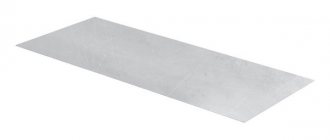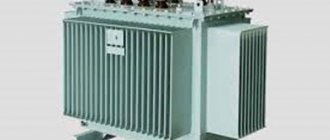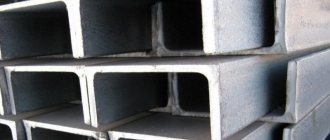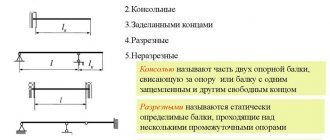Resistance
Imagine that there is a pipe into which stones have been pushed. The water that flows through this pipe will flow more slowly because it has developed resistance. The same thing will happen with electric current.
- Resistance is a physical quantity that shows the ability of a conductor to pass electric current. The higher the resistance, the lower this ability.
Now we will make the “stone section” longer, that is, we will add more stones. It will be even more difficult for water to flow.
Let's make the pipe wider, leaving the number of stones the same - the water will feel better and the flow will increase.
Now let's replace the rough stones that we collected at the construction site with smooth stones from the sea. It is also easier to pass through them, which means the resistance decreases.
Electric current reacts to these parameters in a similar way: as the conductor lengthens, the resistance increases, as the cross-section (width) of the conductor increases, the resistance decreases, and if the material is changed, it will change depending on the material.
This pattern can be described by the following formula:
| Resistance R = ρl/S R - resistance [Ohm] l - conductor length [m] S - cross-sectional area [mm^2] ρ - resistivity [Ohm*mm^2/m] |
The unit of resistance is Ohm. Named after the physicist Georg Ohm.
Be careful!
The cross-sectional area of the conductor and the resistivity contain mm^2 in their units. In the table, resistivity is always given in this dimension, and it is easier to measure a thin conductor in mm^2. When multiplied, mm^2 is reduced and we get the value in SI.
But this does not negate the fact that each problem must be checked to ensure that it contains mm^2 in both quantities! If this is not the case, then you need to reduce the inappropriate value to mm^2.
Know! SI is the international system of units. “Convert to SI” means converting all quantities into meters, kilograms, seconds and other units of measurement without prefixes. The exception is the kilogram with the prefix “kilo”.
- The resistivity of a conductor is a physical quantity that shows the ability of a material to pass electric current. This is a tabular value, it depends only on the material.
Basic concept
Ever since the days of secondary school, namely such a subject as physics, information about the resistivity of the conductor has been present in our memory. Some people will no longer remember the exact definition, but they will remember for the rest of their lives what this term represents. Let us consider in more detail what the definition of this term sounds like - this is a physical component that characterizes the properties of a conductive component that interferes with the passage of electricity. This value is equal to the voltage present at the ends of the wire and the current that flows through this element. In this particular case, we looked at what determines the resistance of the conductor used. In addition, special formulas were provided in physics lessons that made it possible to calculate the necessary values of a given quantity, knowing only individual variables. While most people may not need this in everyday life, in a number of exceptional cases, when carrying out repair work on their own, the previously provided information may be required. Those who deal with electricity on an ongoing basis need to know all the information about this value.
Important. Previously, we looked at what resistance is, however, in order to more accurately understand this term, we should also consider additional information, as well as the calculation procedure and the materials used.
Ohmicity is one of the inductive properties of electrical circuits.
When AC voltage is applied to an electrical circuit, if the current passing through the circuit is in phase with the applied voltage, it means that the circuit is behaving ohmically.
Ohmic circuits contain resistance elements. However, even if an electrical circuit contains resistors, capacitors, and coil elements, the circuit can behave as an ohmic circuit. In this case, this means that capacitive and inductive effects cancel each other out.
In other words, this means that inductive and capacitive reactance cancel each other out.
How is reactance measured?
In itself, the phenomenon of reactance is characteristic only of circuits with alternating current. It is designated by the Latin letter “X” and measured in Ohms. Unlike the activity variant, reactance can have both positive and negative meanings. The “+” or “-” sign corresponds to the sign by which the phase of the electric current and voltage shifts. The sign is positive when the current lags behind the voltage and negative when the cat leads the voltage.
Important! Absolutely pure electrical reactance has a phase shift of ± 180/2. That is, the phase “moves” by π/2.
What does it depend on
The electrical resistance of the conductors used is not a constant value, it depends on a number of individual points. Let us consider in more detail the dependence of this value:
- A material that is used as a conductive element for electric current.
- The length, and in addition, the cross-sectional area of the wiring used, which are present in the circuit.
- The order of connecting resistors and wiring (parallel or series combination).
- In addition, the dependence of the conductor on the temperature that is present inside the conductive element is highlighted.
- A load that is applied from a power source to the ends of a conductive element where the size is calculated.
- The amount of electrical current that is present within a single closed circuit used to calculate values.
- The existing atmosphere (for example, in sub-zero weather and on a hot day, the resistance of some materials is different).
- The age of the source of energy passage used (as is known, any material deteriorates over time, which is why its resistance decreases).
Important. In practice, metals are almost always used as conductive materials, since these elements have the smallest size, which allows electricity to move freely through them.
Which resistance is called reactive and which is active?
Active electrical resistance is an important parameter of the electrical network, which determines the conversion of electrical energy entering a section of an electrical circuit or a separate electrical element into any other type of energy: chemical, mechanical, thermal, electromagnetic. I consider the transformation process irreversible.
Types of the quantity under consideration and formulas for its calculation
Reactance is otherwise called reactance and is the resistance of electrical circuit elements, which is caused by measuring the strength of electric current or voltage due to the existing capacitance or inductance of this element. During reactance, an exchange process occurs between an individual network component and an energy source. This concept is often referred to as simple electrical resistance, but it differs in some respects.
The flow of alternating current does not depend on the type of resistance of the elements and the entire network
Ohm's law.
And here the fundamental law of all electronics – Ohm’s law – comes to our aid:
The current in a circuit is directly proportional to the voltage and inversely proportional to the resistance of the section of the circuit in question.
Let's consider the simplest electrical circuit: As follows from Ohm's law, the voltage and current in the circuit are related as follows:
I = frac{U}{R}
Let the voltage be 10 V and the circuit resistance be 200 ohms. Then the current in the circuit is calculated as follows:
I = frac{10}{200} = 0.05 = 50medspacemA
Formula for calculation
Any calculation starts with a formula. The basic formula for calculating conductor resistance is:
R=(ρ*l)/S
Where R is the resistance in Ohms, ρ is the resistivity, l is the length in m, S is the cross-sectional area of the wire in mm2.
This formula is suitable for calculating the resistance of a wire by cross-section and length. It follows from it that the resistance changes depending on the length; the longer, the greater. And on the contrary, depending on the cross-sectional area, the thicker the wire (large cross-section), the lower the resistance. However, the quantity designated by the letter ρ (Po) remains unclear.
Calculating resistance
All data can be obtained from the tables.
So, we remember - the wire is thicker, the resistance is less. The following will provide instructions on how to calculate everything accurately.
- To do this, we need to find out the resistivity of the conductor material. In ordinary networks you are unlikely to find silver wires, so we take standard copper as a basis. It is 0.017.
- The wire resistance itself is calculated using the following formula: ; where R is the resistance, p is the resistivity of the conductor, l is the length of the wire and s is its cross-sectional area.
- Let's assume that your stoves together can load a network of 16 Amps, this means that we can take a wire with an area of 0.75 mm2. We remember that you require a minimum of 20 meters. So, we consider: 0.017*20/0.75 = 0.45 Ohm
- You can use the table, but the result will not be as accurate. We see that 100 meters of copper wire of the cross-section we need has a resistance of 2.38 Ohms. We divide this value by five (up to 20 meters) and get 0.476 Ohms - the difference is at the level of error, but still.
- Due to the fact that electricity flows through two wires, we multiply the resulting value by 2 and get 0.9 Ohm.
- Now you can calculate the voltage loss using the formula: dU = R*I = 0.9*16 = 14.4 Volts.
- We convert the resulting voltage into a percentage: 14.4V/220V*100 = 6.54%
According to existing standards, 5% voltage loss is allowed. As you can see, in our case the value turned out to be larger, which means that the conductor resistance is too high, so we increase the cross-section of the wire and repeat the calculations.
So, we have found the resistance of the wire, and as you can see, doing this with your own hands and head is not so difficult. The attached video will help you understand the material further. Approach the matter wisely, because the price is the safety of you and your home.
Coil resistance
Active resistance is determined by the ohmic characteristics of the winding wires. When operating at low frequencies, the ohmic resistance does not depend on frequency. In powerful devices, it is necessary to take into account the proximity effect, which consists in the fact that currents and the magnetic field they generate cause displacement of the current in the wires of adjacent turns. As a result, the effective usable cross-section of the wire decreases and its ohmic resistance increases.
Note! At high frequencies, the skin effect appears, which consists in the fact that the current is displaced into the surface layers of the wire. As a result, the usable cable cross-section is reduced. To reduce the skin effect, instead of one conductor, a bundle of several thinner ones is used - Litz wire, or the surface of the wire is coated with a layer of silver, since it has the lowest resistivity.
Skin effect
In powerful electromagnetic systems (particle accelerators), to reduce active resistance, the property of superconductivity is used - the complete disappearance of resistance when some materials are cooled below a critical temperature.
Litz wire
In many cases where inductors are used, the effect of winding resistance must be taken into account. This parameter can have a negative effect not only by reducing the quality factor, but also cause increased heating of the winding conductors when the device operates with high currents.
How to find ohmic resistance in a circuit?
It can be learned from Ohm's law, which relates current, voltage and resistance. In this case, it is calculated using the formula
resistance formula through Ohm's law
Where
R - resistance, Ohm
U - voltage at the ends of the conductor, Volts
I - current flowing through the conductor, Amperes
That is, we just need to measure the voltage at the ends of a conductor and measure the current passing through it. Then apply the formula and calculate the conductor resistance. Let's solve a simple problem to consolidate.
Task
Calculate the resistance of the conductor if it is known that a voltage of 5 Volts is applied to it and the current passing through it is 0.1 Ampere.
Solution
We use the formula
In electronics and electrical engineering, special radioelements are used that resist electric current - resistors. You can read more about them in this article. fixed resistors
Also here is a video where a very smart teacher explains what resistance is
Active power for an AC circuit with active resistance
The rate of conversion of electrical energy into another type of energy over a finite period of time, much longer than the period of current change, is characterized by average power. It is equal to the average power over the period, which is called active.
Active power is the arithmetic average of instantaneous power over a period.
For the circuit under consideration, the active power P can be easily determined from the graph in Fig. 13.2. The average power value is equal to the height of a rectangle with a base T, equal to the area bounded by the curve p(t) and the abscissa axis (shaded in the figure).
The equality of areas PT = Sp is satisfied if the height of the rectangle is taken equal to half the greatest instantaneous power Pm.
In this case, the part of the area Sp located above the rectangle fits exactly into the remaining unshaded part of it:
P=UI
The active power for a given circuit is equal to the product of the effective values of current and voltage:
P = UI = I2R
From a mathematical point of view, active power is the constant component in the instantaneous power equation p(t) [see expression (13.2)].
The average power over a period can be found by integrating equation (13.2) within the period:
Resistance R, determined from formula (13.3) by the ratio of the active power of the circuit to the square of the effective current, is called active electrical resistance.
Ohm's law for a circuit section
With pebbles in a pipe, everything is clear, but not only does the force with which the flow of water flows through the pipe depend on them, it also depends on the pump with which we pump this water. The harder we pump, the stronger the current. In an electrical circuit, the pump function is performed by a current source.
For example, the source may be a galvanic cell (a conventional battery). A battery works based on chemical reactions inside it. These reactions release energy, which is then transferred to the electrical circuit.
Any source necessarily has poles - “plus” and “minus”. The poles are its extreme positions, essentially the terminals to which the electrical circuit is connected. Actually, the current flows from “+” to “-”.
We already have two quantities on which the electric current in the circuit depends - voltage and resistance. It seems it is time to combine them into law.
The current strength in a section of a circuit is directly proportional to the voltage at its ends and inversely proportional to its resistance.
Mathematically it can be described like this:
| Ohm's law for a circuit section I = U/R I - current strength [A] U - voltage [V] R - resistance [Ohm] |
Voltage is measured in Volts and shows the difference between two points in the circuit: this difference determines how much current will flow - the greater the difference, the higher the voltage and the stronger the current will flow.
Current strength is measured in Amperes, and you can read more about it in our article
Let's solve several problems using Ohm's Law for a section of a circuit.
Task times
Find the current strength in an incandescent light bulb if the floor lamp is connected to a 220 V network and the resistance of the filament is 880 Ohms.
Solution:
Let's take Ohm's law for a section of the circuit:
I = U/R
Let's substitute the values:
I = 220/880 = 0.25 A
Answer: The current passing through the light bulb is 0.25 A
Let's make it more difficult. And we will find the current strength, I know all the parameters for calculating the resistance and voltage.
Problem two
Find the current strength in an incandescent light bulb if the floor lamp is connected to a 220 V network, and the length of the filament is 0.5 m, the cross-sectional area is 0.01 mm^2, and the resistivity of the filament is 1.05 Ohm*mm^2/ m.
Solution:
First, let's find the resistance of the conductor.
R = ρl/S
The area is given in mm^2, and the resistivity also contains mm^2 in dimension.
This means that you can substitute values without converting to SI:
R = 1.05*0.5/0.01 = 52.5 Ohm
Now let's take Ohm's law for a section of the circuit:
I = U/R
Let's substitute the values:
I = 220/52.5 ≃ 4.2 A
Answer: The current passing through the light bulb is approximately 4.2 A
Now let's make it even more complicated! Let's determine the material from which the filament is made.
Problem three
What material is the filament of the light bulb made of, if the table lamp is connected to a 220 V network, the length of the filament is 0.5 m, its cross-sectional area is 0.01 mm^2, and the current in the circuit is 8.8 A
Solution:
Let's take Ohm's law for a section of the circuit and express the resistance from it:
I = U/R
R = U/I
Let's substitute the values and find the resistance of the thread:
R = 220/8.8 = 25 Ohm
Now let’s take the resistance formula and express the resistivity of the material from it:
R = ρl/S
ρ = RS/l
Let's substitute the values and get:
ρ = 25*0.01/0.5 = 0.5 Ohm*mm^2/m
Let's refer to the material resistivity table to find out what material this filament is made of.
Instantaneous power in an alternating current circuit with active resistance.
With variable voltage and current values, the rate of conversion of electrical energy in the receiver, i.e. its power, also changes. Instantaneous power is equal to the product of instantaneous voltage and current values: p = Umsinωt * Imsinωt = UmImsin2ωt
From trigonometry we find
A more clear idea of the nature of the change in power in a circuit is given by a graph in a rectangular coordinate system, which is constructed after multiplying the ordinates of the voltage and current curves corresponding to a number of values of their common argument - time t. The dependence of power on time is a periodic curve (Fig. 13.2). If the time axis t is raised according to the drawing by the amount p = Pm√2 = UmIm√2, then relative to the new axis t' the power graph is a sinusoid with double frequency and an initial phase of 90°:
Thus, in the original coordinate system, the instantaneous power is equal to the sum of the constant value P = UmIm√2 and the variable p':
p = P + p'
Analyzing the instantaneous power graph, it is easy to notice that the power remains positive during the period, although the current and voltage change their sign. This is achieved due to the phase coincidence of voltage and current.
It will be interesting➡ Switch connection diagram
The constancy of the power sign indicates that the direction of the flow of electrical energy remains unchanged during the period, in this case from the network (from the energy source) to the receiver with resistance R, where the electrical energy is irreversibly converted into another type of energy. In this case, electrical energy is called active.
If R is the resistance of the conductor, then, in accordance with the Lenz-Joule law, electrical energy in it is converted into heat.
Ohm's law for a complete circuit
We have dealt with Ohm's law for a section of a circuit. Now let's find out what happens if the circuit is complete: it has a source, conductors, resistors and other elements.
In this case, Ohm's Law is introduced for a complete circuit: the current strength in a complete circuit is equal to the ratio of the EMF of the circuit to its total resistance.
EMF stands for electromotive force. It is denoted by the Greek letter ε and is measured, like voltage, in Volts.
- EMF is the force that moves charged particles in a circuit. It is taken from the current source. For example, from a battery.
A chemical reaction inside a galvanic cell (this is synonymous with a battery) occurs with the release of energy into an electrical circuit. It is this energy that causes particles to move along the conductor.
Voltage and EMF are often equated and said to be the same thing. Formally, this is not so, but when solving problems, most often there really is no difference, since these quantities are both measured in Volts and define processes that are very similar in essence.
In the form of a formula, Ohm's Law for a complete circuit will look like this:
| Ohm's law for a complete circuit I = ε/(R + r) I - current strength [A] ε - EMF [V] R - resistance [Ohm] r - internal source resistance [Ohm] |
No source is perfect. In problems this is possible (“consider the source ideal,” these are the phrases), but in real life it’s definitely not. In this regard, the source has internal resistance, which prevents the flow of current.
Let's solve the problem for a complete circuit.
Problem
Find the current in a complete circuit consisting of one resistor with a resistance of 3 Ohms and a source with an emf equal to 4 V and an internal resistance of 1 Ohm
Solution:
Let's take Ohm's law for a complete circuit:
I = ε/(R + r)
Let's substitute the values:
I = 4/(3+1) = 1 A
Answer: The current in the circuit is 1 A.
Areas of manifestation
The reactance of electrical resistance manifests itself in capacitance and induction. The first is determined by the presence of capacitance in the conductors and windings or the inclusion of various capacitors in the AC electrical circuit. The higher the capacitance of the consumer and the angular frequency of the electric current signal, the lower the capacitive characteristic.
You may be interested in this Features of active-capacitive load
The resistance that a conductor provides to alternating current and the electromotive force of self-induction is called inductive. It depends on the inductance of the consumer. The higher its inductance and the higher the frequency of alternating electric current, the higher the inductive electrical resistance. It is expressed by the formula: xl = ωL, where xl is the electrical induction resistance, L is the inductance, and ω is the angular frequency of the current.
Capacitive reactance electrical resistance manifests itself, for example, in a capacitor, which accumulates electricity in the form of an electromagnetic field between its plates. Inductive electrical reactance can be observed in an inductor, which stores energy in the form of a magnetic field inside its winding.
Any resistor, power lines, windings of a transformer or electric motor can have active electrical resistance.
EMF induction can be observed in the throttle
Thus, active resist and reactance differ in many ways from each other, not only by the difference in name, but also in physical properties. The first type converts electricity into another form and releases it into the environment. The second one returns it back to the power grid.
Table of resistivities of various materials
| Specific resistance ρ, Ohm*mm2/m | Specific resistance ρ, Ohm*mm2/m |
| Aluminum | 0,028 |
| Bronze | 0,095 – 0,1 |
| Bismuth | 1,2 |
| Tungsten | 0,05 |
| Iron | 0,1 |
| Gold | 0,023 |
| Iridium | 0,0474 |
| Constantan (Ni-Cu + Mn alloy) | 0,5 |
| Brass | 0,025 – 0,108 |
| Magnesium | 0,045 |
| Manganin (alloy of copper, manganese and nickel – instrument) | 0,43 – 0,51 |
| Copper | 0,0175 |
| Molybdenum | 0,059 |
| Nickel silver (an alloy of copper, zinc and nickel) | 0,2 |
| Sodium | 0,047 |
| Nickelin (an alloy of copper and nickel) | 0,42 |
| Nickel | 0,087 |
| Nichrome (an alloy of nickel, iron chromium and manganese) | 1,05 – 1,4 |
| Tin | 0,12 |
| Platinum | 0.107 |
| Mercury | 0,94 |
| Lead | 0,22 |
| Silver | 0,015 |
| Steel | 0,103 – 0,137 |
| Titanium | 0,6 |
| Hromal | 1,3 – 1,5 |
| Zinc | 0,054 |
| Cast iron | 0,5-1,0 |
Determination of active resistance of wires
It is easiest to determine the active resistance of wires using reference data compiled on the basis of GOST 839-80 - “Bare wires for overhead power lines”, tables 1 - 4. You can find these tables directly in GOST itself, I will give just a few. It is not recommended to use all known formulas for determining active resistance [L1. p.18], this is due to the fact that the actual cross-section differs from the nominal cross-section, the wires were produced at different times, according to different GOSTs and specifications, and the values of conductivity (ρ) and resistivity (γ) are different:
Where:
- γ – the value of specific conductivity for copper and aluminum wires at a temperature of 20 °C is accepted: for copper wires – 53 m/Ohm*mm2; for aluminum wires – 31.7 m/Ohm*mm2;
- s – nominal wire (cable) cross-section, mm2;
- l – line length, m;
- ρ – the resistivity value is accepted: for copper wires - 0.017-0.018 Ohm*mm2/m; for aluminum wires – 0.026 - 0.028 Ohm*mm2/m, see table 1.14 [L2. p.30].
The active resistance of steel wires cannot be calculated mathematically. Therefore, I recommend using appendices P23 - P25 [L1.] to determine active resistance. p.80,81].
How to measure the ohmic resistance of cable insulation
Before testing, remove residual charge from disconnected live parts. This is done by connecting them to the ground bus. The contact jumper is removed only after connecting the measuring device. At the end of the test, the residual charge is removed again by briefly shorting it to ground. You can find the resistance value in two ways: either using a calculation or a table, or directly using instruments.
According to the PUE table
Resistance values depend on the cross-section of the element conducting the electric current and the material from which it is made.
Aluminum wire table
This is usually copper or aluminum. The main values are shown in the table:
Table for copper wire
Using instruments
Typically, the equipment used to make measurements is divided into two groups: panel meters and meggers. The first is used for mobile or stationary electrical installations with an independent neutral. Indicators and relay components are included in a typical insulation monitoring equipment design. These meters can operate in continuous mode and can be used in 220 V or 380 V AC networks with different frequencies.
In most cases, the measurement is made using a megger. It differs from conventional ohmmeters in that it can operate at fairly high voltage values generated by the device itself. There are two types of megohmmeters:
- Analog.
Analog device
- Digital.
Digital sensor A standard megger contains three sensors. The following are connected to them: protective grounding, test leads, shielding. The latter is used to eliminate leakage current.
The measurement method can be expressed as follows:
- The test voltage is selected according to the requirements of the production line. For example, for home wiring, the value is set in the range from 100 to 500 V.
- When using a digital device, you must press the “Test” button, and on an analog device, turn the knob until the indicator shows the required voltage value.
- Connect the linear output of the tester to the test core of the cable, and the grounding output to the harness of the remaining wires. That is, each core is checked in relation to the remaining electrical wires electrically connected to each other.
Important! If the received data is unsatisfactory, each core in the cable is checked separately.
- Record all obtained values and compare them with specifications.
Connecting the sensor to cables
Alternating current
In order to understand what active resistance is, it is necessary to understand the phenomenon of alternating current itself. An alternating current is a type of current that continuously changes the direction of its flow. During flow, the alternating current potentials are constantly changing. This occurs due to the operation of the generator, or more precisely due to the interaction of the magnetic field with the copper winding. The movement can be clearly seen using an oscilloscope. Its shape resembles a sinusoid.
It will be interesting➡ Features of using pass-through switches
The role of alternating current is difficult to overestimate. Its main advantage is the ease of transmission from source to consumer, the ability to lower or increase the voltage using transformers. Also, alternating electric currents can be delivered to the consumer at much lower cost.








